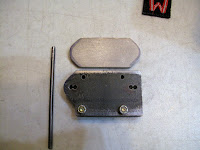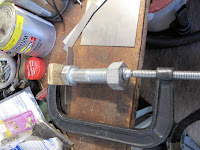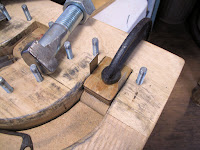Wings and Wheels Museum at Poplar Grove, Illinois has built a replica Curtiss Jenny. They had help from EAA Chapter 1414 as well as access to the original Curtiss Drawing. They flew it to Oshkosh in 2022. I need to find out if they had access to the exhaust manifold drawings.
I built them a set of exhaust manifolds for their motor. They've had a few problems and I'm slowly working on how to solve them. Their main request is to make them from 321 Stainless Steal instead of 1018 Mild Steel.
The first problem was a flange which broke. The other problem was considerable internal corrosion. Clearly stainless steel solves the corrosion problem. I didn't use stainless to make these because although it was invented in 1913 it wasn't readily available until well after WWI. My other reason was that I had no experience with stainless steel.
I may never be a big fan of stainless steel. It has some obvious advantages for reducing corrosion. The 321 composition was created to make a more weldable material than the more common 304 stainless. One disadvantage of 321 stainless is it's much higher cost. A 12"x12" piece of 0.032" thick 321 stainless cost me $25. I bought a 4 ft x 8 ft sheet of 0.032" 1018 steel for $35. The set of manifolds take 4 pieces 12" x 30" and 4 pieces 12" x 12".
The other disadvantage is that it not as strong, more of an issue for the flanges.
The Yield Strength is:
1005 Low Carbon Steel 41,000 psi
1018 Cold Rolled Steel 53,700
4130N Chromoly Steel 75,000
321 Stainless Steel 25,000
The last disadvantage is that stainless is reported to be more difficult to weld. There is a fair amount of welding on each manifold.
Having said all that I've bought some pieces of 321 stainless and am learning how to make the manifolds from it.
My first task was to shear some strips to Spot Weld and do the edge fold. My shear won't shear the 0.032" thick sheet. It has no problem with the 0.032" 1018 sheet steel. I used my snips cut some strips 1/2" wide to experiment with.
I spot welded some pieces then tried prying them apart. They were very strong, I could not pry them apart.
Then I spot welded pieces with one piece longer than the other and hammered the long piece over the short to make the folded edge on the shells. I had no problem doing it and find no cracking, looking with a 10x glass.
The next test was to cut out a portion of the shell blank and hammer it to shape. It formed fine and I think will work fine on a full piece.
The way I've been forming the rectangular inlet causes the steel in the side walls to be stretched. Everywhere else on the shell the steel slides into the hole in the form bloc, therefore it doesn't thin the metal by stretching. These side walls need to be as strong as possible to help support the manifold when the flange is bolted to a shaking motor.
I had made some hardwood blocks for the inlet of each tube. These blocks limit the depth of the wide flat part. This controls the height of the rectangle so it matches the outlet of the cylinder port.
By leaving these out I was able to pull the metal further into the block. This leaves a round bottom, like the tubes. Then I took the block apart, added the blocks and reassembled it so I could square up the rounded bottom. I need to make some new blocks to limit the depth of the round bottom, so it has just enough length to form the square bottom. This method got rid of the stretching in the sides.
The 2 tubes came out really well. I should be able to form the shells and spot weld them together. I need to experiment with welding the edges where the flange isn't wide enough to spot weld. My Dillon torch claims to weld stainless and my wife got me a small TIG welder for Christmas. We'll see what works best.
I'm working on the flanges now. When I made the mild steel ones I bought 1-1/2" wide 3/16" bar stock. I have only found 2-1/2" wide bar stock in 321 stainless. I'm making them from 1/4" instead of 3/16" thick because of the lower strength of the stainless. The lack of 1-1/2" bar stock means a lot more bandsaw time, but it seems to cut OK.
I'll also have to modify my fixtures for drilling and cutting the holes.


















































